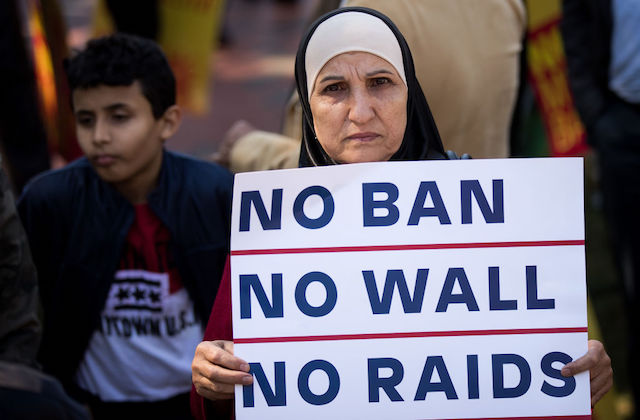The New Normal: Fear and Loathing as Immigration Policy

We made it through 2017! But sometimes, it looked like we wouldn’t survive a year that seemed intent on shaking up the status quo. Soon after President Donald Trump took up residence in the White House, he signed executive orders that vastly changed the nation's approach to immigration. In this installment of The New Normal, Colorlines contributor Alfonso Serrano details how Trump leveraged fear to close America's borders.
For those hoping for a more nuanced immigration policy than the one Donald Trump outlined on his quest for the Oval Office, the president’s first week in office proved jarring.
Within days of his inauguration, Trump signed an executive order expanding the range of immigrants who can be deported and authorizing more local officials to enforce immigration law. Two days later, he followed that directive with an executive order that banned citizens of seven Muslim-majority countries from entering the United States.
In one week, Trump succeeded in turning fear into a policy provision. Chaos reigned at United States airports, immigrants with undocumented status began skipping work, parents kept their children from school, and children whose parents were at risk for deportation began showing signs of trauma from psychological stress.
As Trump settled into the presidency, his administration began increasing the frequency of high profile immigration raids that rounded up hundreds of immigrants, targeting sanctuary cities that limit cooperation with federal immigration authorities. Although federal judges have blocked some of Trumps orders, his message remains clear: no immigrant is off limits.
The Department of Homeland Security bolstered that message when it released figures for fiscal year 2017 showing that detentions of non-criminal immigrants nearly doubled compared to 2016, and that Border Patrol arrests decreased by 25 percent.
The Trump administration has also targeted immigrant communities that enjoyed protection under previous administrations. In November, it announced that it would end Temporary Protected Status for roughly 59,000 Haitians who fled their country in 2010 following a devastating earthquake. This group, many with U.S.-born children, has 17 months to leave the U.S. or face deportation.
But Trump crystallized the cruelty of his immigration policy in September, when he ended an Obama-era program, Deferred Action for Childhood Arrivals (DACA), that shields from deportation some 800,000 immigrants who were brought to the U.S. as children, know as Dreamers. The move was widely panned as shortsighted. The fate of DACA recipients now rests on Congressional leaders, with top Democrats vowing to abstain from voting on a year-end funding bill unless it contains provisions to protect Dreamers from deportation.
It's unclear if Democrats can stem the tide of Trump's fear-driven immigration policy before the New Year.
